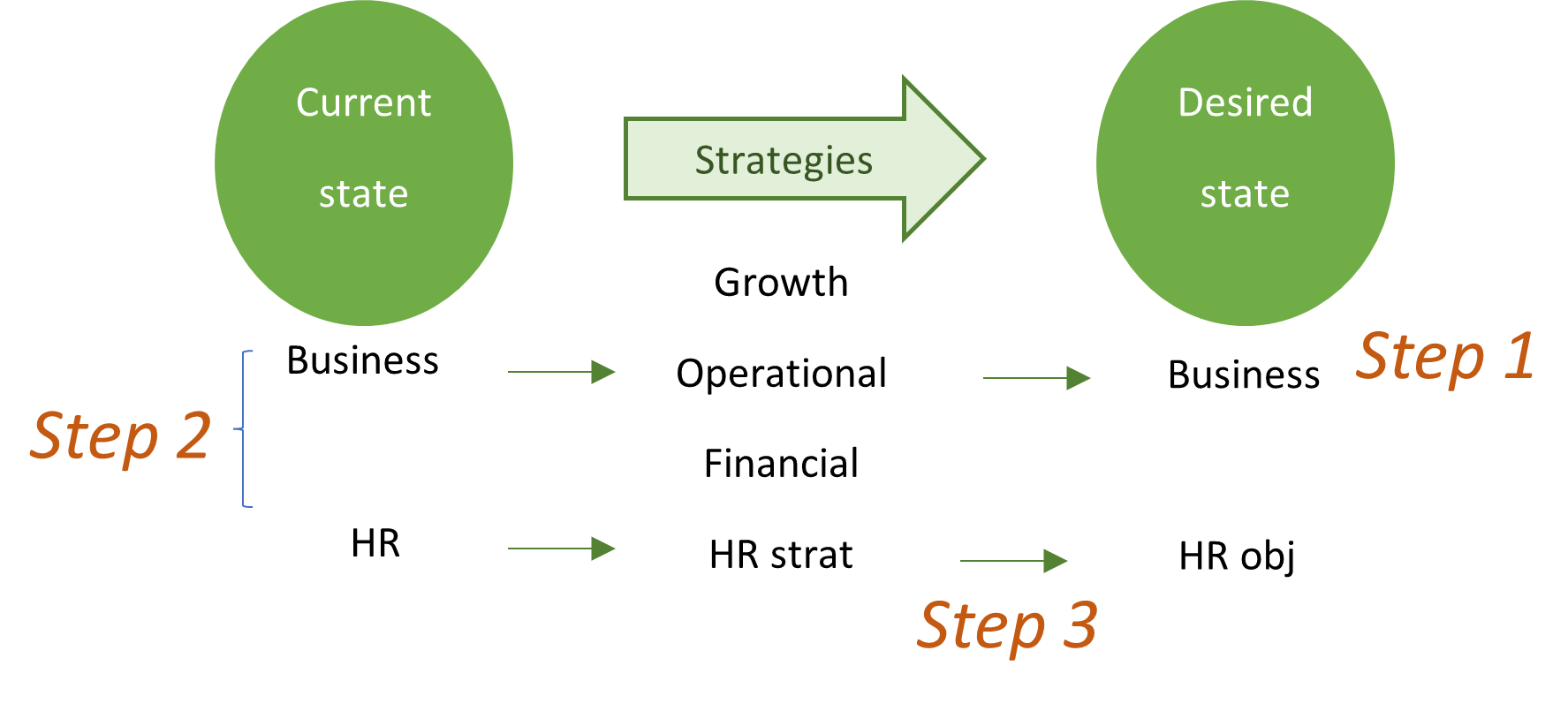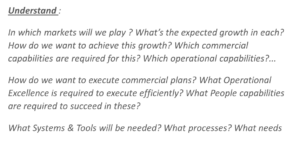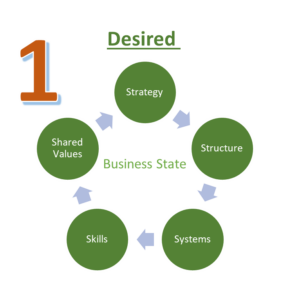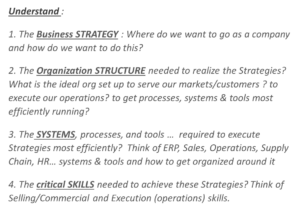This article recommends a process outline for creating this plan. It is supported by a simple, pragmatic, value-proven template to complete. Let’s review and reflect on the process steps and share some best practices for completion.

Step 1: What are the short, mid, and long-term Business Objectives, Strategies and Plans? Describe the “desired state” of the Business context.

It’s important to have a clear understanding of the company’s overall strategy and how it applies to your specific business area. This includes knowing the financial, commercial, and operational goals, as well as the obstacles that might prevent you from achieving them. You should also be familiar with the key strategies necessary to reach these objectives and the people challenges related to achieving these.
Best practices
|
A simple and pragmatic model can help to facilitate team discussions and to structure and share your HR plan comprehensively. The 7S model of McKinsey is one example I often use (although I only use 5 S’s). This model shows that to win as a business you’ll need to define, understand, and align on the 5 S’s.


Make a high-level (e.g. one page) overview of all business strategies and objectives to achieve them. Indicate the key business KPIs for measuring success. A concise and shared understanding of the desired state in all 5 S-domains and the alignment needed between them, is required.
Step 2: Describe and Analyze the “current state” of the Business Context.

Where is your company now on all aspects of the desired state? You can use the same model to structure (e.g. 5 S). Focus on the following:
- Determine your current position. Establish a baseline describing your current state by collecting measurable data on all Business-related KPIs.
- Analyze the gap between your current and desired state. Briefly describe the commercial, operational, financial, and people gap that needs to be closed. Describe what supporting changes will be needed in Org Structure (geographies, divisions/departments, jobs…), Systems (process/systems/tools…), Skills, and Shared values/culture.
- Identify the People/HR-related needs for change (across all 5 S’s). Describe the current state using short bullet points, highlighting strengths, weaknesses, opportunities, and threats. Determine what needs to be started, stopped, done more, and/or done differently. Collect HR related KPI’s as baseline. What challenges may arise? Define the People/HR issues and needs to solved and/or responded.
- It is important to involve your management team in order to create common understanding and alignment. Prioritize and focus on the most important HR related issues and needs.
Step 3: Define the HR Objectives, Strategies & Plans needed to achieve the desired state.

Review prioritized HR challenges, issues and needs and define HR objectives to achieve the desired state. It is crucial to ensure that your leadership agrees not only with your HR objectives but also with the strategies and plans to achieve them. Build your HR scorecard objectives and plan, covering all HR domains.
- Organizational Development objectives.
- Look from both the “Total Organization” and the “HR organization only” perspective.
From the “Total Organization” perspective, what are the big changes in Strategy? (e.g. new markets, new acquisitions, integration of mergers and/or acquisitions, different sales capabilities required, better customer service, higher sales & execution productivity, lower G&A cost, …). Related to this Strategy change, what changes are required to the Organization Structure (jobs, departments, reporting lines…)? the company Systems and processes? the Critical Skills and capabilities? the Culture/Values/Behaviors
From the “HR Organization only” perspective, what changes are needed in the HR organization structure, HR systems and processes, HR skills and behaviors? How can you optimize HR cost ? How can you best organize your Talent Acquisition activities to support priorities and face the recruitment challenges optimally? How can you best involve line management in HR activities? (in recruitment, in training,….) . What can you do to empower line managers to own their HR responsibility
Depending on the size of organizational transformation that is required versus the current availability of supporting HR processes and tools within your organization, this set of objectives will move up or down on the priority list.
- Workforce capacity and planning objectives.
- Specify labor quantity, quality, and cost targets.
What are workforce-related cost targets? What capabilities are needed? When? What productivity/efficiency improvement is needed? If capabilities need to be stopped and/or labor costs need to be reduced, what are restructuring needs? Define priorities and phasing/planning taking business goals into account (sellers to grow top line vs productive employees to execute vs affordable supporting functions…).
- Talent Acquisition Objectives to achieve your workforce needs.
- Specify quantity and quality/capability level of specific jobs needed.
Take into account expected turnover, internal rotation (career development), and desired capabilities targets (incl D&I): how many replacements will you need to anticipate? how many additions to recruit? what will be the challenges to achieve your TA targets? which supportive actions will be needed to attract, select, and retain talent? do you have a good Employee Value Proposition? do you need to improve retention? how ?…
- Objectives to ensure a High-Performance Culture.
- Specify improvement targets for your Performance Management, Employee Engagement, and Reward and Recognition policies, processes and practice.
E.g. quality of your objectives setting and cascade process, the quality of your HR tools, skills, practices, policies,… the line management capability to own and manage these processes and tools, your Pay for Performance policy and practice (your Total Rewards processes and practice in terms supporting compensation, incentives and benefits programs)
- Talent Management and Development Planning objective.
- Specify improvement targets for your Talent Management, Learning & Development and Career Development policies, processes and practice.
E.g. Are efficient tools available? Are Talent Reviews/Round Tables happening qualitatively? Are updated Talent Review & Succession Planning reports ongoing available for the agreed audiences? Are they ongoing reviewed with the management team? Are qualitative Individual Development Plans defined & managed? How strong is your succession/leadership pipeline? Is your Talent Management Action Plan defined, managed, and tracked? What are your D&I targets?
Define also targets concerning the “collective” development needs that are strategically important to develop commonly (e.g. your company-wide specific programs for sales, for leader development, for managing execution …)
- Employee and Industrial Relations objectives and plans.
- Specify improvement needs on current HR policies & practices, also on current Industrial Relations climate, strategies, and plans to support optimal all required changes. Outline targets and requirements and tactical negotiation plans for implementing change.
- What additional HR initiatives are needed to support Organizational Transformation?
- Specify which role HR will play to make the required business transformation (if any) successful.
Take into account:
-internal communication needs (comprehensive change communication, tailored to all audiences so that all employees understand what the transformation/change means for them),
-Talent Management and Learning & Development needs (understand available Talent; identification of key players/change agents needed, what are overall competencies/capabilities needed and how do you want to achieve this ? …),
-motivational needs (recognition & reward of change efforts…);
-behavioral/cultural change needs
Behavioral change requirements are critical for the success of Organizational Transformation, including M&A integration. However, they are often the most challenging objectives to achieve. HR will need to take the lead and implement large-scale interventions, starting with leader-led behavioral change initiatives. For instance, by ensuring that all leaders understand the required changes and that they themselves will need to train and coach their teams on the new behaviors.
Conclusion
To create an effective HR plan, as an HR leader, you need to have a clear understanding of what organizational success looks like. Regardless of the level you operate in the corporate organization, it is essential to coordinate (ideally facilitate) the process of cascading business strategies and objectives. You should also work with your business leaders to define and agree on the HR objectives and plans that respond to the HR/People challenges they are facing.
The more you involve and align business leadership in developing and tracking your plan, the better you will partner with them, resulting in a more successful plan. Although it may take some time to gather and analyze all the information, your goal should be to summarize it in a 3-5 page document, making HR priorities and focus clear for yourself and others. By doing this, you’ll create a powerful frame of reference to manage all your HR actions against.

